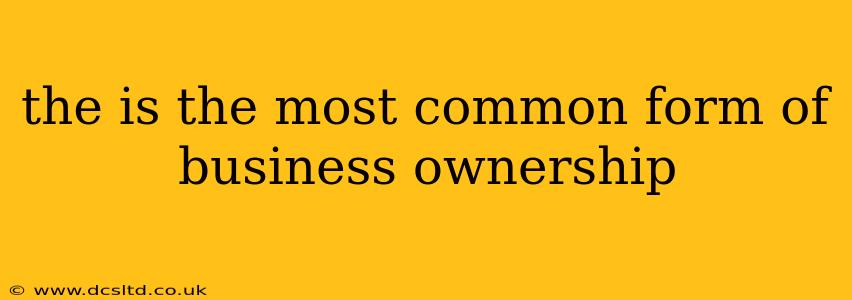The Most Common Form of Business Ownership: Sole Proprietorships Explained
The most common form of business ownership is the sole proprietorship. This simple structure is attractive to many entrepreneurs due to its ease of setup and minimal regulatory requirements. But what exactly constitutes a sole proprietorship, and why is it so prevalent? This article will delve into the details, addressing common questions and highlighting its advantages and disadvantages.
What is a Sole Proprietorship?
A sole proprietorship is a business owned and run by one person, and there is no legal distinction between the owner and the business. This means the owner directly receives all profits but is also personally liable for all business debts and obligations. It's the simplest business structure to form, requiring minimal paperwork and legal formalities. Often, it's the natural starting point for many small businesses and freelancers.
What are the Advantages of a Sole Proprietorship?
- Ease of Setup: Starting a sole proprietorship is typically straightforward. In most jurisdictions, you may only need a business license and potentially other permits depending on your industry and location. There’s no complex registration process involving multiple parties.
- Simple Taxation: Profits and losses are reported on the owner's personal income tax return, simplifying the accounting process. There's no separate tax filing for the business itself.
- Complete Control: As the sole owner, you have complete control over all aspects of the business, from decision-making to day-to-day operations.
- Flexibility: Sole proprietorships offer significant flexibility in terms of management and operational changes. Decisions can be made quickly without needing approval from partners or shareholders.
What are the Disadvantages of a Sole Proprietorship?
- Unlimited Liability: This is arguably the biggest drawback. The owner is personally liable for all business debts and obligations. This means personal assets, such as a house or car, could be at risk if the business incurs significant debt or faces lawsuits.
- Limited Capital: Raising capital can be challenging. Sole proprietors often rely on personal savings or loans, limiting their access to significant funding opportunities.
- Limited Growth Potential: The business's growth is often tied to the owner's capacity and resources. Expanding significantly might require considerable personal investment and effort.
- Difficult to Transfer Ownership: Transferring ownership is complex. It often requires selling the business assets rather than simply transferring ownership shares.
What are the Alternatives to a Sole Proprietorship?
Several alternative business structures offer different advantages and disadvantages:
- Partnership: Involves two or more individuals sharing ownership and responsibility.
- Limited Liability Company (LLC): Provides limited liability protection for owners while offering flexibility in taxation.
- Corporation (S Corp or C Corp): Offers more robust liability protection but involves more complex legal and regulatory requirements.
How Do I Choose the Right Business Structure?
The optimal business structure depends on individual circumstances, risk tolerance, and long-term goals. Factors to consider include liability concerns, tax implications, capital requirements, and long-term growth aspirations. Consulting with a legal and financial professional is strongly recommended before making a decision.
Is a Sole Proprietorship Right for My Business?
This is a question only you can answer, considering your specific business needs and personal risk tolerance. While the simplicity and ease of setup are attractive, the unlimited liability associated with a sole proprietorship is a significant consideration. Weigh the pros and cons carefully, and seek professional advice before making a final decision. Understanding the implications of this structure is crucial for long-term business success.
